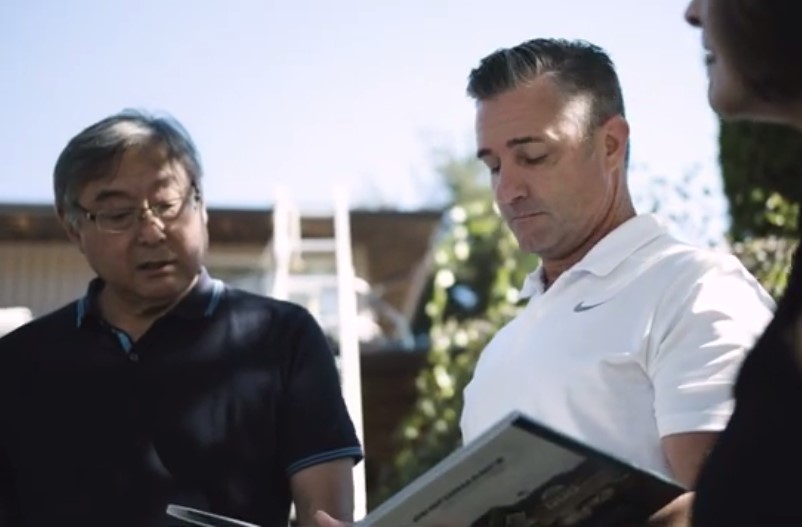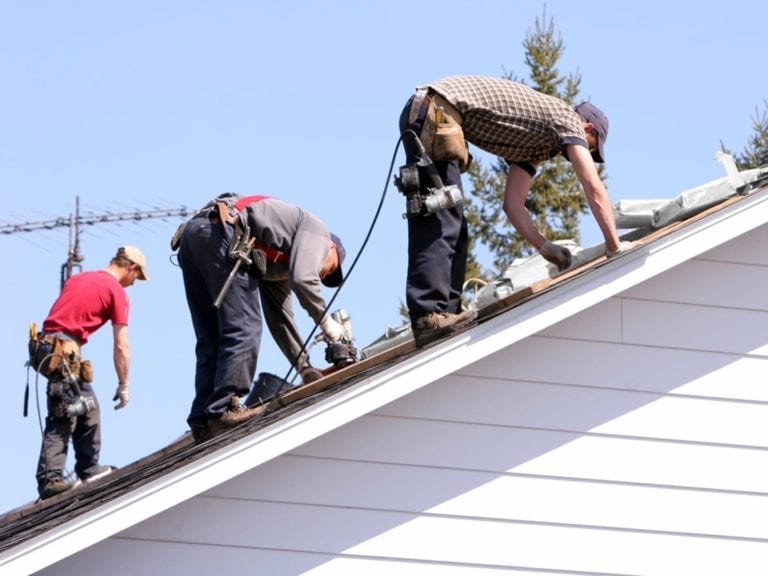The Complete Guide to Roofing Sales
Roofing companies need salespeople to create leads and convert them into customers. As a salesperson working in roofing, you’ll need knowledge about roofing products and the specific kinds of sales strategies that are most likely to work to convert the roofing customers your company is trying to serve. Jumping right into the world of sales can be daunting, not least because you can expect potential customers to reject you very frequently, especially at first. However, with the right mindset, education and strategies, you can successfully sell roofs. There’s plenty to learn, and in this guide, we’ll walk you through the whole sales process with actionable tips to help you improve. We’ll also cover information you need to know before you approach a single customer.
- Things To Know Before You Start
- The Sales Process
- Canvassing
- Qualifying
- Pitching
- Strategies To Pitch Roofing Services
- Closing
- Follow-up
- How To Improve as a Salesperson
- Get a Partner
- Record Your Results
- Seek Support and Education
- Becoming a Great Roofing Salesperson
Things To Know Before You Start
Heading right to knock on a door without any preparation is often a mistake. The world of roofing sales is not unlike other sales positions, where the company should provide you with appropriate training before you begin. If you have experience with sales, then you may need training to understand roofing. If you have experience with roofing, then you may need education in sales. Ideally, you’d receive training in both. Every company you work for will have different offerings and brand identity, not to mention they may use different sales techniques for different kinds of customers. You will need to know all of this and more.
Your training should consist of at least these basic components:
- Estimating: If you are responsible for providing homeowners with the estimate or bid for their roofing work, your company should walk you through the estimating process. You should be able to tell customers all of the different roofing materials they will need and what they will cost. Estimating will involve getting on the roof, measuring it and typically using software to create your homeowner’s estimate. Every company does this differently, so it is important to be aware of how your company does it.
- Products: From shingles to underlayment and flashing, your company will offer different products. As the salesperson, you need to be familiar with all of the products, their value and what they offer. Together, a set of roofing products may make up a roofing system. For example, IKO has PROFORMAX™ integrated roofing accessories that work best with IKO shingles. From certain manufacturers, using a whole system may enable a homeowner to receive a different limited warranty than they would otherwise.
- Insurance process: Many homeowners are overwhelmed at the process of making a claim through their homeowner’s insurance plan. Salespeople who can guide homeowners can help build trust, put them at ease and ensure that the whole repair or reroofing process goes smoothly. While a roofing company cannot sway adjusters and cannot cover deductibles, they can still offer invaluable support to help homeowners. As the salesperson, you should be able to tell the homeowner exactly how you can support them through the insurance claims process.
- The value of repairs or a new roof: You’ll spend much of your time listening to a homeowner’s worries or stresses, otherwise known as “pain points.” You’ll then need to communicate how your company and a new roof or roof repairs, in general, can relieve those pain points. You are offering them a solution to a painful problem. To that end, it is wise to understand the value of a roof.

Beyond the training you receive from your company, there are a few things to consider on your own before you start talking to homeowners.
- Mindset: Potential customers will reject you frequently. If you work door to door, you will typically receive more rejections from homeowners than approvals to get the roofing work done. That’s just the nature of any sales position. Although, those who sell to customers who reached out to their roofing company first will be rejected less. Still, rejection is common, and the better you can prepare yourself for this mentally and keep yourself from becoming guarded or frustrated, the more successful you’ll be. Some salespeople have naturally cheery dispositions and can easily protect their self-esteem from rejection and hard days. Others struggle with it. Try to remember that you’re offering something many people genuinely need. “No’s” have no reflection on your character or worth as a person. And getting to “no” quickly is best, so you have more time to focus on the people who will say “yes.” We’ll explore how to get to “no” quickly later on.
- Honesty: When a homeowner asks a question that you don’t know the answer to or that you’re not sure of, tell them so. Making promises that the roofing team can’t keep is a bad idea. Setting expectations you can’t live up to will also backfire. It will look better on the company, and you’ll keep the homeowner’s trust if you are honest when you don’t know. Make a note to discover the answer and get back to the homeowner, which will help develop rapport and trust. That said, it is better to have the answers. So, make sure that you know everything you can about typical questions homeowners ask. With experience, your knowledge base will grow.
- Care: Most successful salespeople will argue that caring about the customer and their needs is critical. You are not trying to trick or overly pressure someone into buying a roof from your company. Strategies that apply too much leverage like this may be successful initially, but the homeowner may cancel as soon as you leave. That’s because they aren’t really sold on the value of what you’re offering. The secret to many successful sales strategies is to care about what the customer really needs and then to try to offer it to them.
The Sales Process
The roofing sales process has five main steps: prospecting, qualifying, pitching, closing and following up. Let’s walk through them one by one.
Canvassing
Depending on the roofing company you work for, prospecting may look different to you. You may be canvassing or performing door-to-door sales. In this case, your canvassing process may be looking at which neighborhoods are most likely to need roofing work or which neighborhood your company may want to target. Or you may be cold-calling or following up on leads that your company gets you through marketing initiatives.
Qualifying
Qualifying is all about finding out whether the customer you’re talking to is a good match for the roof that you’re selling. In all sales, there are three basic components to qualifying: pain, budget and authority. Here’s what they look like in the roofing industry in particular:
- Pain: Does your customer need a new roof or roof repair? Has a storm damaged their roof? Is it old, leaking or perhaps even a poor visual match for their home’s exterior? Sometimes you can reveal to a customer that they need a roof repair or replacement with an inspection, but others may already know they need a new roof.
- Budget: Does your customer have enough money to afford the roofing they need or the roofing they want? Your company may offer roof financing options that can help you overcome budget hurdles.
- Authority: Does the specific person you’re speaking to have the authority to make the purchasing decisions for the roof? You may be talking to a renter who doesn’t own the property. Or you may be talking to one member of a couple who doesn’t typically make the purchase decisions. Most salespeople in North America find that the partner who is raising the kids has decision-making power, as he or she spends more time at home. However, it can also be ideal to get both partners together for a sales pitch so that they can confer with each other right away.
How do you find out if your prospect has these three qualities? Right after you introduce yourself and explain why you’re at their door, start asking open-ended questions that can help you find answers as well as build rapport. It isn’t wise to directly ask an uncomfortable question like: “Can you really afford a new roof?” However, people will volunteer information when you get them talking. Options for open-ended questions include:
- Do you know whether you need a new roof?
- How did your roof fare after the last storm?
- Have you noticed any signs that your roof might be aging?
- When was the last time you had a roof inspection?
- Have you thought about getting a new roof?
You may start with these questions or with a script that your company has given you. Then, over time, it’s likely that you’ll come up with your own unique questions that feel most genuine coming from you or which are most successful with the individuals that you’re selling to.
The secret to this step is to listen carefully to what the prospect says to you. Some salespeople believe that it is a smart strategy to rush at a customer and get a whole pitch out before they have even listened to a word the prospect has said. You might get more people to reluctantly let you on your roof with this strategy, but, overall, it is less successful and can be a big waste of time. If someone is not qualified, they will not buy your services. Further, such an aggressive strategy can be off-putting even to those who do need a new roof. If you don’t actively listen to their situation, you will likely lose out on sales because you won’t understand their needs.
Pitching
Once you know that your prospect is qualified, it is time to pitch to them. Pitching is essentially offering your services. You communicate that your company has what the customer needs and the value that these services provide to the customer. There are plenty of different pitching strategies, perhaps even one for every salesperson. You will probably start with the pitching strategies that your company has taught you. Over time, you’ll learn to present a slightly different pitch based on the information you learned about the prospect in the qualifying stage. You may also develop your own unique strategies to sell in your specific market.
Strategies To Pitch Roofing Services
We’ll go over some common strategies used to sell roofing below. You’ll need to start some of these strategies right from when you come into contact with the homeowner during the qualifying stage.
- Zig Ziglar: Zig Ziglar is a famous salesperson who has a tremendous number of classic sales tips to offer. Some of the tips that are most useful for roofing include balancing information and emotion. Too much logic or information and you may struggle to close the sale because people act on emotion. Too much emotion and you’ll close the sale, but the person really isn’t sold on the value of the roof and may feel buyer’s remorse. Establish the value of the roof and use emotion to motivate the prospect to act on that knowledge.
- LAER: LAER is a bonding process from Carew International. LAER stands for “listen, acknowledge, explore and respond.” In this strategy, when a prospect gives you information, you follow all four steps to build a rapport and get them closer to a close. For example, if a prospect says that they don’t have money for a roof right now, you listen to them. Then, acknowledge their concerns, perhaps by agreeing that roofs are expensive. You can then explore their concerns, asking if they plan on saving money or if they expect to afford the roof some other way down the line. Then, respond by offering your financing options. LAER helps you respond more appropriately and build rapport because the prospect feels acknowledged and that you genuinely care about their concerns. It will help you overcome objections later on.
- Friendship: This approach is all about being genuine, listening to the prospect and treating them as a potential friend and not just a sales goal. Most who use this approach will start by asking the person how their day is going. They’ll give honest information about how their day is going in return. Typically, salespeople who build off friendship have natural charisma and avoid canned lines, feeling out when to naturally transition to talk about roofing.
- Education: Newer sales tactics are more about educating prospects than building a friendship with them. The internet empowers people to look at the products and services they are considering buying ahead of time. Consumers are used to weighing the pros and cons of different options on their own, and this is true for roofing too. If you can help them with this process by offering truly valuable information that educates them about their roof and not just restate what they found online, then you will earn their trust and their business. For example, if you learn how to spot poor roof design and can educate a customer about that, you can showcase your company’s roofing expertise.
- Buyer-Seller Agreements: Many people move through their sales pitch without acknowledging that the prospect is also involved and has a choice about what happens next. Verbally create buyer-seller agreements about what is to happen next. This can be as simple as asking, “Can I show you some shingle samples?” Instead of just pulling them out. Along the same lines, you can ask the customer if they are following what you’re saying, if you’re talking too fast and more.
Things To Include in Your Roofing Pitch
As we discussed above, your pitch should be highly tuned to the specific prospect that you’re working with. You should be comfortable enough with it to drop certain parts, respond to your prospect’s thoughts and adjust it in other ways as you figure out what matters to them. However, you should still have an expansive script so that you can draw on any element that you’ll need. Here is a general list of things you could include in that pitch script:
- How your company stands out from the competition.
- The story of your company.
- Your company values.
- Before and after images of shingled roofs.
- Multiple shingle options.
- Warranty information.
- Customer testimonials.
- Online reviews of recent jobs.
- Your quality standards.
- Financing information.
- Any roofing technology your company uses.
- A prompt to set a time to follow up with them.
Sometimes concise pitches can be better. It all depends on your unique style and the customer whom you’re dealing with. However, any of these elements can help you be more successful.
Closing
Closing is the lynchpin in the selling process. It is essentially asking the prospect if they are ready to buy from you, sign the contract or schedule their roofing work. As you would imagine, people have very different strategies for closing, even within just the roofing industry. Some roofing salespeople find that they need to schedule a second appointment or follow up with the homeowner to close. Others feel that second appointments aren’t necessary, and they can close during their first meeting. You might find one strategy or the other works better depending on your pitching strategy and the kind of prospect you’re talking to. Your best closing strategy will be unique to you. Still, there are plenty of closing strategies you can try before you find what works and some information you should know to make it easier.

Body Language
You can tell that your prospect is ready for you to approach them with a closing offer with body language. CHEF is an acronym for body language coined by Zig Ziglar. Each letter represents a signal that indicates your prospect is ready for you to close. C stands for “chin or cheek”; H is for “hands”; E is for “eyes”; and F is for “friendly.” Acting friendly, making eye contact and touching their chin or cheek, or touching the palms of their hands together are very strong signs the person is ready for your closing line.
Handling Objections
When you attempt to close on a prospect, they may bring up objections. When they do, remember LAER and try to help the prospect with the objection honestly. Of course, sometimes, the objection is not a real hurdle, but an excuse to say “no.” If you sense this, you should accept the objection because that helps the prospect feel respected, and it may turn into a sale later.
If the objection is real, you should have a plan on how to address it and get back to closing. This has to be honest persuasion, where you really address the person’s objection in order to get the sale. Examples of common roofing objections and how to handle them include:
- Finances: If a prospect says they do not have the money for their roofing repairs or replacement, point them to your financing options and even bank loans. It is true that getting a roof repaired will prevent more expensive damage down the road.
- Partner: Prospects may say they need to confirm with their partner, and this may be honest or an excuse. You can ask them to call their partner now or schedule a time to speak with them both.
- Time: Homeowners are busy and may say they don’t have the time to deal with their roof right now. You can express how your company makes it easy for them and saves them time.
- Multiple quotes: Wise homeowners may want to get other quotes before they commit to your company. Make sure you submit your quote and then follow up. Some homeowners will give up on getting other quotes or will get them, but still choose your company.
There are many more potential objections. When you hear an objection that you don’t have a strategy for, you could write it down and spend some time preparing to handle it next time.
When Closing Fails
What if it didn’t work? You can always talk to the prospect a bit more and then attempt to close again. Most salespeople will try multiple closing techniques before giving up or scheduling a time to speak to the prospect again. However, be sure not to harass them.
You will fail to close most of the prospects you talk to unless they are very well-qualified by your company first. That’s perfectly normal, so try not to let it discourage you. In fact, getting to a “no” faster is good, as it gives you more time to spend on prospects who might say “yes.”
Closing Different Kinds of People
You may find that there is a closing strategy that works for one kind of person, but fails to work for others. Over time, you’ll need to develop multiple closing strategies. You’ll also need to learn which ones to try based on your prospect’s income, personality, gender and other characteristics. As a newcomer to the world of sales, you’ll likely be best at closing people who are like you. Talk to more experienced salespeople to learn about other strategies you can use for people who are not like you.
Follow-up
This is the last step in the sales process. While you’ve already made your sale at this point, you don’t want to gloss over this. You follow up with your customer after the roofing work has been done to ensure that they’re satisfied with the work. This helps you establish a long-term relationship with the customer and can help you generate more sales. A satisfied customer may review you positively, be more receptive to giving you referrals and call your company back when they need roofing work in the future. A follow-up is as simple as a call, email or text to ask the customer how it went. Just listen, accept feedback and thank them again for choosing you.
How To Improve as a Salesperson
Now you’re armed with techniques and strategies, but you may still find that your first few days or weeks as a roofing salesperson are less successful than you’d like. How do you improve? There are a few ways you can hone your sales strategy faster.
Get a Partner
Many companies have a policy of assigning new salespeople to shadow experienced salespeople to show them the ropes. An experienced salesperson will have their strategies and will have honed them for the specific kinds of prospects that your company deals with most. Learning from their experience will help you be more successful at first, even if you need to develop your own techniques as you grow.
Record Your Results
Often, the best way to grow at anything is to keep a record of your successes and failures. We suggest keeping track of every single sales attempt, whether it was successful or not, and other information that might help you improve. You could track:
- Where you think you lost the customer in your pitch.
- Questions you were unprepared for.
- Objections you didn’t have an answer for.
- Basic demographic information to see if you perform better with a certain kind of prospect and neighborhood.
- The pitch you used or where you changed your typical pitch.
- The closing strategy you used.
After you have tracked your results for a while, you can review them and analyze which strategies are most successful. Hopefully, you’ll have some important insights, like that a certain closing style works more often, or a certain change in your pitch does well.
Seek Support and Education
The company you work for probably has dozens of other salespeople who face the same challenges you do. Hopefully, there is a strong spirit of camaraderie in your company and a willingness to mentor and learn. Enroll in any additional training that your company offers you and participate in social events, as other more experienced salespeople will often talk about their strategies at these events. You may also wish to sign up for online sales courses offered by third parties.
Becoming a Great Roofing Salesperson
It’ll take experience and effort to become a great roofing salesperson, but with these tips and an understanding of the overall roofing sales funnel, you’re off to a great start. You may also find that there are some roofing contractor apps that can help you make your sales process more successful.







